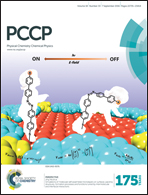Simulations of molecular self-assembled monolayers on surfaces: packing structures, formation processes and functions tuned by intermolecular and interfacial interactions†
Abstract
Surfaces modified with a functional molecular monolayer are essential for the fabrication of nano-scale electronics or machines with novel physical, chemical, and/or biological properties. Theoretical simulation based on advanced quantum chemical and classical models is at present a necessary tool in the development, design, and understanding of the interfacial nanostructure. The nanoscale surface morphology, growth processes, and functions are controlled by not only the electronic structures (molecular energy levels, dipole moments, polarizabilities, and optical properties) of building units but also the subtle balance between intermolecular and interfacial interactions. The switchable surfaces are also constructed by introducing stimuli-responsive units like azobenzene derivatives. To bridge the gap between experiments and theoretical models, opportunities and challenges for future development of modelling of ferroelectricity, entropy, and chemical reactions of surface-supported monolayers are also addressed. Theoretical simulations will allow us to obtain important and detailed information about the structure and dynamics of monolayer modified interfaces, which will guide the rational design and optimization of dynamic interfaces to meet challenges of controlling optical, electrical, and biological functions.

- This article is part of the themed collection: PCCP Perspectives

 Please wait while we load your content...
Please wait while we load your content...